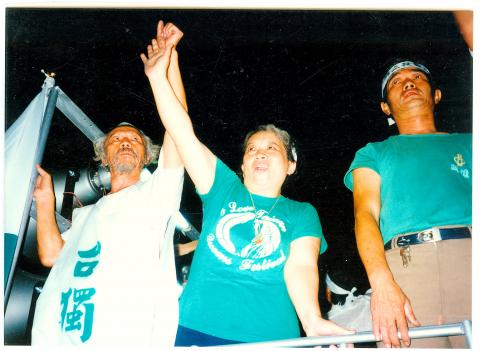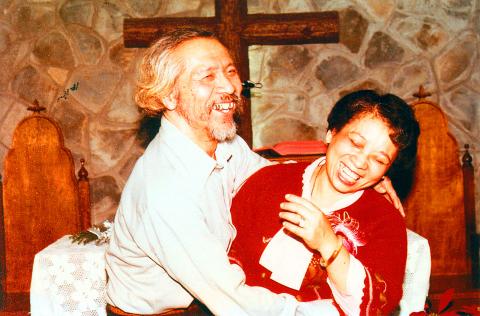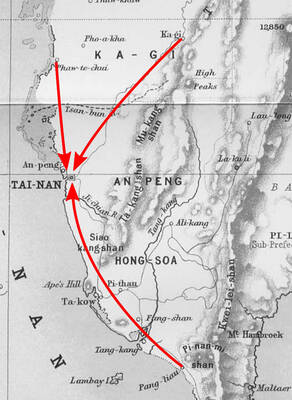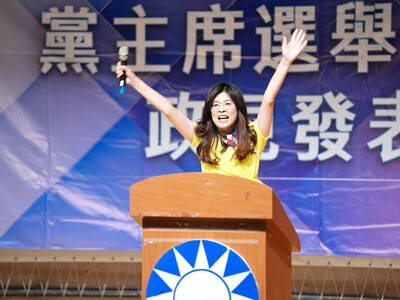To describe a documentary about Taiwan’s democracy movement as an epic love story may seem odd, but that’s what Hand in Hand (牽阮的手) feels like. The latest work by director couple Yen Lan-chuan (顏蘭權) and Juang Yi-tzeng (莊益增) threads together interviews, found footage, animation, archival records and manuscripts to tell of the six-decade relationship between democracy activists Tien Meng-shu (田孟淑) and Tien Chao-ming (田朝明). The couple’s undying love alone, however, is not enough to make the film epic. What transcends the romance is the director’s ambition to join the personal and the political, bringing the country’s past to life through the stories of individuals who lived trough it.
The film begins in 1950s Tainan. A 17-year-old high school girl, Tien Meng-shu, falls in love with Japanese-educated physician Tien Chao-ming, who is 16 years her senior. The young woman’s wealthy, reputable family does not approve of the town doctor, so she elopes with her lover and never returns home. Little did the fearless young lady know that their lives over the next 60 years would closely follow the thread of Taiwan’s post-World War II political history.
The progression focuses on Tien Meng-shu, who grows from an innocent schoolgirl to a devoted advocate of human rights and democracy better known as Mama Tien (田媽媽) among political activists and dissidents. The directors rely heavily on Mama Tien’s memory to conjure up the past, but instead of using archives and talking heads, they ingeniously use animation to bring the story to life. Through the animated sequences, we come to know doctor Tien’s friendship with Taiwanese intellectual and political critic Lee Wan-chu (李萬居) and Chinese scholar and democracy pioneer Lei Chen (雷震), who co-founded Free China (自由中國), a publication that advocated liberalism and was sharply critical of the Chinese Nationalist Party (KMT). The couple become intensely involved in the dangwai (黨外, outside the party) movement, and their clinic becomes a place where political dissidents such as a young Chen Chu (陳菊) — now mayor of Greater Kaohsiung — hold meetings with members of Amnesty International in an attempt to rescue political prisoners and victims of the White Terror.

Photo courtesy of Juang Yi-tzeng and Yen Lan-chuan
One of the film’s heartbreaking moments is an animated sequence depicting Yeh Chu-lan (葉菊蘭), the wife of human rights activist Deng Nan-jung (鄭南榕), as she decides not to stop her husband from setting himself aflame in protest against the lack of freedom of speech under the authoritarian rule of the KMT in 1989. Another sequence shows the Tiens’ oldest daughter, Democratic Progressive Party Legislator Tien Chiu-chin (田秋堇), going to Lin I-hsiung’s (林義雄) home on Feb. 28, 1980, and discovering the appalling murders of Lin’s 60-year-old mother and seven-year-old twin daughters while he was detained on charges of insurrection.
Completed after four years of arduous work by the makers of Let It Be (無米樂, 2005), Hand in Hand brings to light political events such as the 228 Incident, the Formosa Incident and the lifting of martial law not as hollow dates in history books but as parts of people’s lives, showing the passion, strength and sacrifice that helped to shape Taiwanese society.
The film owes much of its power to its protagonists, who are ready to die for their ideals and beliefs. Through this lens, the Tiens’ love for the land remains untainted and incorrupt, and so is the love between the couple as the aged Mama Tien is seen caressing the bedridden Tien Chao-ming, who lost his ability to move and communicate after a stroke in 2004 and passed away last year at the age of 93.

Photo courtesy of Juang Yi-tzeng and Yen Lan-chuan
In the middle of the film, director Juang acts as an off-screen narrator pondering a young blogger’s remark: “How does the 228 Incident have anything to do with me?” The question is answered in Hand in Hand, a must-see for anyone interested in the history of Taiwan’s democracy movement, and even more important for those who don’t think it affects them.

The Taipei Times last week reported that the rising share of seniors in the population is reshaping the nation’s housing markets. According to data from the Ministry of the Interior, about 850,000 residences were occupied by elderly people in the first quarter, including 655,000 that housed only one resident. H&B Realty chief researcher Jessica Hsu (徐佳馨), quoted in the article, said that there is rising demand for elderly-friendly housing, including units with elevators, barrier-free layouts and proximity to healthcare services. Hsu and others cited in the article highlighted the changing family residential dynamics, as children no longer live with parents,

Oct 20 to Oct 26 After a day of fighting, the Japanese Army’s Second Division was resting when a curious delegation of two Scotsmen and 19 Taiwanese approached their camp. It was Oct. 20, 1895, and the troops had reached Taiye Village (太爺庄) in today’s Hunei District (湖內), Kaohsiung, just 10km away from their final target of Tainan. Led by Presbyterian missionaries Thomas Barclay and Duncan Ferguson, the group informed the Japanese that resistance leader Liu Yung-fu (劉永福) had fled to China the previous night, leaving his Black Flag Army fighters behind and the city in chaos. On behalf of the

I was 10 when I read an article in the local paper about the Air Guitar World Championships, which take place every year in my home town of Oulu, Finland. My parents had helped out at the very first contest back in 1996 — my mum gave out fliers, my dad sorted the music. Since then, national championships have been held all across the world, with the winners assembling in Oulu every summer. At the time, I asked my parents if I could compete. At first they were hesitant; the event was in a bar, and there would be a lot

The election of Cheng Li-wun (鄭麗文) as chair of the Chinese Nationalist Party (KMT) marked a triumphant return of pride in the “Chinese” in the party name. Cheng wants Taiwanese to be proud to call themselves Chinese again. The unambiguous winner was a return to the KMT ideology that formed in the early 2000s under then chairman Lien Chan (連戰) and president Ma Ying-jeou (馬英九) put into practice as far as he could, until ultimately thwarted by hundreds of thousands of protestors thronging the streets in what became known as the Sunflower movement in 2014. Cheng is an unambiguous Chinese ethnonationalist,